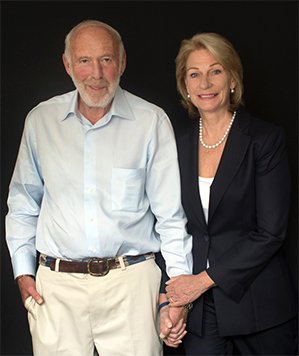 James Simons is secretary and treasurer of the Simons Foundation. He is also board chair and founder of Renaissance Technologies. Prior to his financial career, Jim Simons served as chairman of the mathematics department at the State University of New York at Stony Brook, taught mathematics at the Massachusetts Institute of Technology and Harvard University, and was a cryptanalyst at the Institute for Defense Analyses in Princeton, New Jersey.
James Simons is secretary and treasurer of the Simons Foundation. He is also board chair and founder of Renaissance Technologies. Prior to his financial career, Jim Simons served as chairman of the mathematics department at the State University of New York at Stony Brook, taught mathematics at the Massachusetts Institute of Technology and Harvard University, and was a cryptanalyst at the Institute for Defense Analyses in Princeton, New Jersey.
Marilyn Hawrys Simons has worked primarily in the nonprofit sector as a volunteer for the past 20 years, focusing on education. She has served as president of the Simons Foundation since 1994. Marilyn Simons earned a BA and a PhD in economics at the State University of New York at Stony Brook.
Q: You've said in the past that at the time you started the Simons Foundation, the overall quality of autism research was not very good. How did you go about changing that?
Marilyn: When we're talking about "not very good," that's worth clarifying — there wasn't enough funding for people to do a really rigorous, longer-term, focused, group-effort kind of analysis. So we started by bringing scientific advisors together to talk about how we could accomplish that. First, we found an expert scientific advisor — Gerry Fischbach — who had a wide breadth of experience from NIMH [National Institute of Mental Health], and as a neuroscientist doing his own research, he came with a deep scientific knowledge. Gerry wanted to start small and focus on high quality. He started with personal contacts, with leaders in biomedical science to find out the important questions relevant to autism and developmental disorders. He organized meetings and workshops. Very early on, we developed an emphasis on genetics and wanted to focus on de novo mutations. This was an idea that was put forward by Mike Wigler at Cold Spring Harbor Lab, and he worked together with my husband, Jim, and Gerry to create a data set for us to analyze. We found 12 university collecting sites to help us work with a community of clinicians and lab scientists. We started an annual meeting so that we could bring together scientists who are engaged in the research to discuss how to advance the field. We set up a website to disseminate scientific information. And, most importantly, we made sure that we would fund the effort. Gerry started an RFP [request for proposal] process at our foundation; he sought out superb scientists and asked them to apply. And he established a blue ribbon review panel to evaluate a program for both excellence of the science and relevance to the mission.
Jim: What we did know early on, is that autism is highly genetic. There's an 80% concordance between identical twins, much higher than in any other neurological condition. So we focused on the genetics first. The collection that Marilyn described was started 9 years ago and has been of enormous use to a large community. It's quoted all the time, and people study it. We just had a paper from the Broad [Institute] in which they had used that collection. So scientists came in first because there was money in it, they could get support, and the genetics gave them something to get their teeth into.
Q: Has your strategy changed now that many others are also focused on autism?
Jim: It's great that many others are focused on autism. And we didn't fund many of [the studies that produced] the results that are coming along. But there's a very long way to go. It's a very, very tough nut to crack. Perhaps there's one treatment that's in trial, which might have some positive effect on maybe 20% of people with autism. So we're not yet at a point where we would say that since everyone else is doing it now, we can back off. We are just beginning a whole new collection of 50,000 families — the first one was 3,000. They will all be exome scanned, which is much cheaper to do than it used to be. No one else is doing stuff like that. So we're still in this, and I think it will be 10 years before we have enough progress where we could leave it to the rest of the world.
Q: What motivated the expansion of the Simons Foundation to other areas of science instead of focusing on autism?
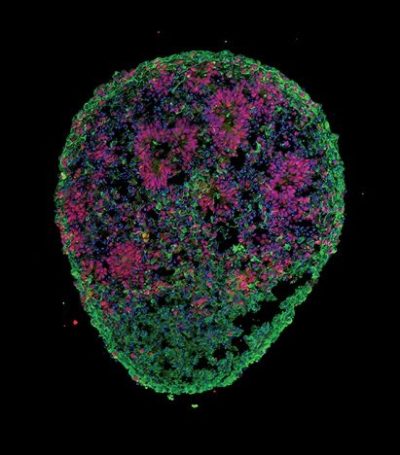
Brain 'organoids' similar to the one shown here, are revealing how the neurons of individuals with autism spectrum disorders differ from those of unaffected family members. Image credit: J. Mariani et al. Cell 162, 375-390 (2015).
Brain 'organoids' similar to the one shown here, are revealing how the neurons of individuals with autism spectrum disorders differ from those of unaffected family members. Image credit: J. Mariani et al. Cell 162, 375-390 (2015).
Jim: We had always had a focus on supporting science, and we had been doing that through giving to institutions like The Rockefeller University, MIT, and other places with which we had strong connections. Once we saw how things worked with what Gerry was doing, we brought in someone to give grants in math and physical science, and that went very well. Then we decided to broaden out and give grants in life sciences. So gradually our focus moved from supporting institutions to supporting individuals and collaborations. Four years ago, we had a meeting at a place called Buttermilk Falls — we got a whole bunch of scientists together for a weekend from all kinds of fields to discuss the possibility of doing goal-driven collaborations. From that meeting emerged a number of ideas for such collaborations. One of them was the origins of life, a very interesting topic, and there is no government support for that kind of research.
The in-house research that we've begun to do has also been very gratifying. We now have people doing computational science in the life science area; we are starting another unit in astrophysics — computational astrophysics — that's going to begin this fall; and we are expecting to have two more such units that will each involve 50–60 people. So we'll do a lot of in-house research — no wet labs, but using data from other people's labs, collaborating with them to develop better ways to analyze data and learn things from that analysis.
Marilyn: To put that in perspective, the autism program was up and running, and you can only move so fast. You have to wait for some results before you could move on to the next set of questions. And our endowment was growing, our budget was getting bigger, and we were so inspired by the work that Gerry was putting into play related to autism and so inspired by the scientific research, that we wanted to expand our efforts.
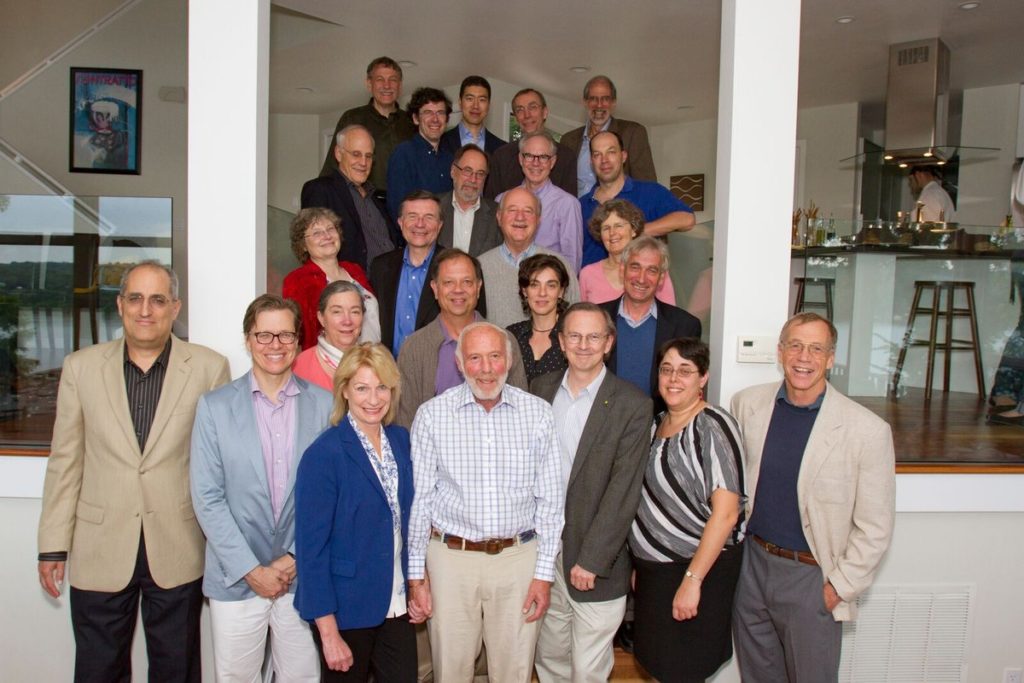
Buttermilk Falls meeting
Q: Is there any concern about becoming too big?
Marilyn: No.
Jim: No. We know how much we can spend, and that's what we'll do.
Q: It is often said that philanthropists tend to invest in riskier projects that the government doesn't want to fund. How is your strategy of evaluating grants different from, say, that of the NIH?
Marilyn: Because we're a private foundation, we have the flexibility to do some things that are harder for the government to do. For example, we'll fund researchers across disciplines and across institutions, and we'll ask the scientists to meet periodically to work together. We talked with the head of OSTP [Office of Science and Technology Policy], and he was saying that there are some areas that the government isn't going to fund, like origins of life, for example. It's an area that doesn't have immediate practicality and, in fact, might not have a long-term one, either.
Q: But the government funds basic research, too; what makes topics like origins of life different?
Jim: The NIH is focusing more and more on translational research, as opposed to basic research, and likes to give grants to people whose work is almost completed so they can be certain that it's going to work. We can be a little more flexible, and we can focus on the people, rather than their particular research plan. I believe that you're better off with the best people in the world working for you even if you think their plan might be a little crazy.
Marilyn: It's also really hard for the government to fund interdisciplinary research. We could fund the early stages of a project, but we could also take a longer-term view: we could think about a big project that could take 10 years and stick with the researchers [during that time]. That's a harder thing for the government to do.
Q: Aren't you afraid to waste your money when you invest in those projects that are "a little crazy?"
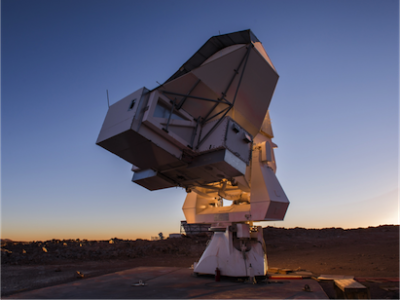
The 3.5-meter Huan Tran Telescope hosts POLARBEAR, an experiment designed to make measurements of B-mode polarization of the cosmic microwave background. The telescope will be part of the new Simons Observatory.
Jim: Whether the big payoff will come or not can't really be predicted. But that's not wasting money. If they're good scientists, you are likely to learn something. If you're a venture capital fund, you might start 20 companies, and you know that 10 of them are going to fail, 5 of them are going to do ok, and maybe 5 will do really well. I don't think that what we're doing is as variegated as that. But nonetheless, some of these things won't work. We're doing a big telescope project now, a collaboration between Princeton, the University of Pennsylvania, UC San Diego, and Berkley, and we put up 40 million dollars for this collaboration. They're going to build telescopes and they're searching for things that are not easy to find. But this is work that they really wanted to do. The Department of Energy wants to get into this area, and they plan to build on what we're doing and put up even more money 5 years from now, but they wanted something to happen without them first.
Q: About these public-private research project dynamics — what is the relationship between the Simons Collaboration on the Global Brain and the Brain Initiative? Did you learn about the Brain Initiative, find it exciting, and decide to join, or were you approached by the government to set up a collaboration?
Jim: Neither of those. We determined to do [the Collaboration on the Global Brain] in 2012. That was one of the things that came out of this Buttermilk Falls meeting. We determined to do it and began workshops before the Brain Initiative was announced, before we knew anything about it. At a certain point, they included us as private people who were also doing brain studies, but the government program is about developing better technology, and our program is looking at the dynamics of large collections of neurons and trying to understand the dynamics of the brain. It's a pretty exciting project, and it's been going for 2.5 years now.
Marilyn: We have our own programs that we label as collaborations, meaning that they are across institutions and across disciplines. We're not collaborating with the government, but we are one of the several foundations who are in alignment with the idea of trying to understand the brain more deeply and more fundamentally.
Q: How do you see the role of philanthropists in supporting science? Do you think the public should worry that private interests will be increasingly driving the direction of science?
Jim: No! No.
Marilyn: I don't think so. I think having private philanthropy is great, but that's no substitute for government support for basic science research. The government is really the main driver of basic science research in our country.
Jim: It's the largest driver.
Marilyn: We've had a nice relationship working in an informal way with scientists in the government. When we were first interested in learning more about the scientific landscape of autism research, Tom Insel, the head of the NIMH [National Institute of Mental Health], came to our round table to help us think through the issues. It was really helpful to get a broad view and advice. Tom Insel was also helpful over our first couple of years with information on how we could have conferences and identify potential scientists who might be interested in this research. But there are still niches and areas that it's not as easy for the government to do work in, and private philanthropy could be really helpful there.
Jim: Philanthropic support for science is much older than government support for science. It was philanthropists who supported Galileo, for example. And you know, the Greeks supported Archimedes. Probably rich Greeks. It's a long history of private philanthropy supporting science. Government support really skyrocketed after the [second world] war and has grown considerably. I don't know when the NIH was created, but the Rockefeller Foundation and the Rockefeller Institute were supporting medical research before the government got into the act. The role that we can play is to be somewhat more adventuresome and not be hamstrung. We don't feel that every state in the Union should get its share of our funding, whether or not there are really great people in that state or not. There are constraints that the NIH works under that we don't.
Marilyn: One thing that we were surprised to see when we talked with different foundations and private philanthropists was that people were very interested in basic science and wanted to get involved. It was more a matter of learning how they could they do that. One of the most common questions is about scientific advisory boards. How do you get scientific advisors to help you in making your funding decisions?
Q: What are some of your current challenges?
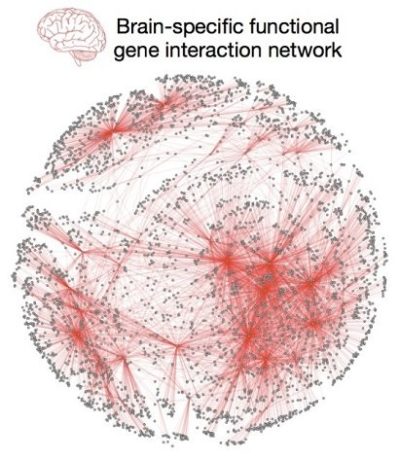
A gene-interaction network used to predict whether a gene was associated with autism. The network was built by computationally integrating thousands of genomic experiments. Image courtesy of Arjun Krishnan/Princeton.
Marilyn: We wanted to see if we could help with some of the algorithmic analysis of all the data that we are generating. One of our goals has been to look at genetic algorithmic research to see if we could help the investigators we are funding by giving them more tools for analysis. Also, algorithmic analysis of data produced in brain studies will be useful to many researchers. Analyzing spike sorting methods is one example. You could do one probe to one cell and see what one cell is doing. But when you have a bunch of probes, how can you sort out what the different neurons are doing? So we have an internal research project related to those kinds of algorithmic analyses, and then hopefully we'll be able to disseminate this algorithm to different researchers participating in our global brain collaboration.
Jim: Infrastructure is very important. Going back to that first collection that we made in the autism project — that was a piece of infrastructure that facilitated a great deal of experimental work. Spike sorting is [currently used] in four labs, and within a few months we'll release it [for general use]. It's a much better algorithm; it doesn't involve humans, which the previous ones did, and it's much faster and somewhat more accurate. So everyone wants that. But we have to be able to support it and answer questions, and in a few months we'll be able to do that. We already have a great algorithm for calcium imaging, which is another way to look at neuronal activity, that is now in 50 labs.
Marilyn: This was something that came out of our Buttermilk Falls meeting — in the age of big data, how can we derive some helpful results? Given Jim's background in mathematics and even code cracking, which he used to analyze financial markets, it really resonated with all of us here at the foundation that creating that kind of infrastructure might be helpful to the kind of research we were interested in funding.
Q: How do you measure success for the foundation or the various projects that you have?
Jim: I used to run a company where every day I knew the profit or the loss that we made that day. So I had a one-dimensional measure — are we making money or are we losing money? Here, there's no such simple measure. There used to be a question, which reached the Supreme Court, about pornography. They wanted a definition, and they only came up with "Well, you'll know it when you see it." You know a good result when you see it, and in some cases it's clear and it's terrific. In other cases, it could look very promising even if it might not apply to anything in the real world, at least not right away. There aren't strict measurements, such as with what frequency a paper was cited, but we think we have a pretty good idea of when we're getting somewhere.
Marilyn: When you invest in basic science, you only know about the impact [of your investment] over the long term. It could be decades, or generations even, and you may never know the causal relationship. But when you love the knowledge and the research, you have those inspiring "aha" moments when you are starting to understand fundamentals and you feel a sense of satisfaction.
Q: What are the dynamics of your partnership as a couple in relation to managing the foundation and making decisions? What are the different roles, and what decisions do you make together?
Marilyn: Jim and I never imagined working together. We've been married over 38 years now, and we've been doing very different, separate things. Working together here at the foundation started about 6 years ago on a day-to-day basis. Jim is a scientist himself. He is the person who works closer with the scientists, he loves and can understand the internal mathematical research, and he is looking at the science of our grant-making program. What I'm focused on is operations and communications, our public face, and our public outreach.
Jim: I make sure things are running right, on the investments end, and I oversee the actual programs, except for the outreach program, which Marilyn is on top of. So that's the division of labor.
Marilyn: And when we're talking about a new project, it's not only Jim and me but all the scientists in-house who are part of that decision.
Jim: So it's not perfect, but it's pretty good!
